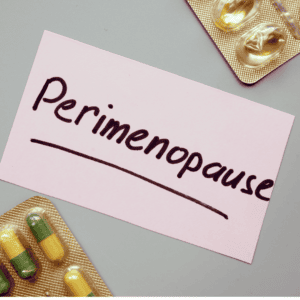Perimenopause
Perimenopause? What is that?!

More and more women are talking about perimenopause. So what is it? The way I usually start off with describing it is as a “reverse puberty”. Puberty is when a woman begins to have cyclical ovarian function which leads to cyclical hormonal fluctuations, and she will continue to have this for many years. Perimenopause is when the ovaries are getting ready for retirement and these fluctuations get a little less regular. By definition, perimenopause means the time around menopause. Menopause is the cessation of monthly menstrual cycles, and the average age in the United States for this last period is age 52. But it’s not all about periods. Let me explain.
The Natural Continuum of Womanhood

Perimenopause can begin 2-10 years prior to that last menstrual period, meaning it can begin in her mid to late 30s. Perimenopause is not pathologic by nature, but part of the natural continuum of womanhood. However, the declining and erratically fluctuating levels can lead to bothersome symptoms, for which are important for her to get the care she deserves. There is no lab test to determine perimenopause, and “checking your hormones” can often be low yielding. The hallmark of the beginning of perimenopause is some changes with her period. Periods may be longer, heavier, more clots, more painful and they may occur more frequently. Likewise, she may start skipping periods and they may become lighter. Along with menstrual cycle changes, she may experience a multitude of other symptoms. Some menopause experts say there are over 200 symptoms (and counting!) associated with perimenopause. These may include hot flashes, night sweats, mood changes, irritability, rage, trouble sleeping, heart palpitations, fatigue, brain fog, trouble concentrating, joint pain, weight gain especially around mid section, constipation, vaginal dryness, urinary frequency, pain with penetrative intercourse, decreased desire, trouble with orgasm, low motivation, hair thinning, itching or dry skin. These physical and mental changes can also be associated with social and environmental changes she is experiencing as well. For example, changes with her career, going back to school, caring for teens, caring for aging parents, changing romantic relationship dynamics. She may also be grieving this transition as well as the loss of her fertility.
How to Manage Perimenopause

So, what can she do? First and foremost, take care of herself. Prioritize self care, decrease alcohol consumption, stop smoking, focus on whole foods and do not restrict eating, and continue body movement that feels good to her. Second, prioritize sleep! There could never be enough emphasis on sleep. If you are struggling with sleep, it is time to see a healthcare provider. Third, set boundaries. During perimenopause, she may be feeling a loss of control, decreased sense of self, and we know that depression, anxiety, and irritability can increase. For these reasons, it may be easy for her to say “yes” without putting herself first. And lastly, there are several evidenced based treatment options for her, so it is critical she find work with a trusted medical provider who can help guide her during this time period. Every perimenopause woman has different needs, and therefore recommendations should be prioritized, personalized and individualized. Seek a Menopause Specialist by going to menopause.org.
Written by Christina Saldanha, PA-C, MSCP, CSC, IF of Camel City Women’s Wellness
